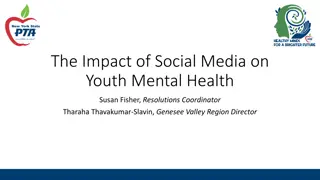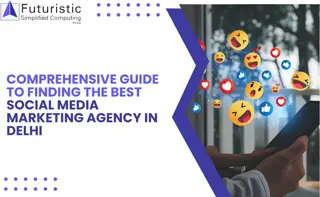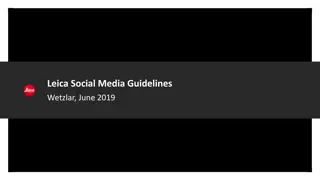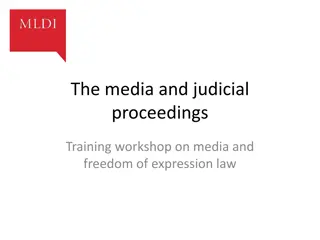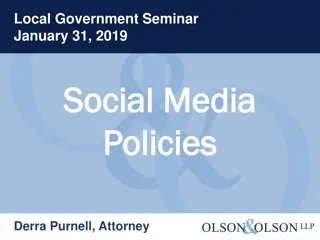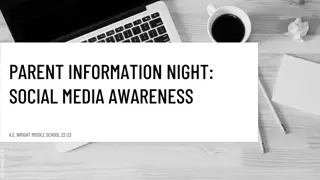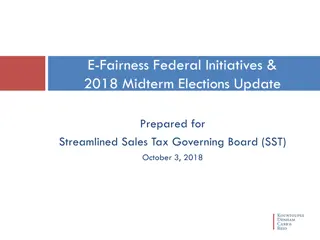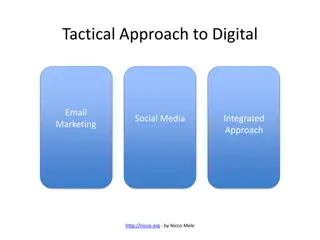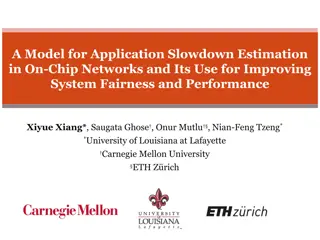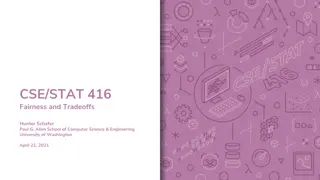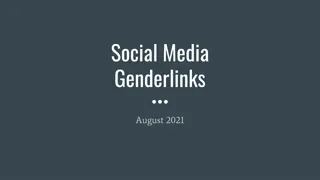Ensuring Fairness and Diversity in Online Social Networks and Media
Embracing fairness and diversity in online social networks and media is imperative to combat discrimination and biases. From addressing data correctness and completeness to understanding processing algorithms and disparate treatment, the quest for fairness through blindness and individual fairness is highlighted. By recognizing the importance of non-protected attributes in classification and prediction, we strive for a digital landscape that treats similar individuals similarly, promoting a more inclusive and equitable online environment.
Download Presentation

Please find below an Image/Link to download the presentation.
The content on the website is provided AS IS for your information and personal use only. It may not be sold, licensed, or shared on other websites without obtaining consent from the author.If you encounter any issues during the download, it is possible that the publisher has removed the file from their server.
You are allowed to download the files provided on this website for personal or commercial use, subject to the condition that they are used lawfully. All files are the property of their respective owners.
The content on the website is provided AS IS for your information and personal use only. It may not be sold, licensed, or shared on other websites without obtaining consent from the author.
E N D
Presentation Transcript
Online Social Networks and Media Fairness, Diversity 1
Fairness, Non-discrimination To discriminate is to treat someone differently (Unfair) discrimination is based on group membership, not individual merit Some attributes should be irrelevant, called protected, or sensitive 2
What is the cause? Data Correctness and completeness Garbage in, garbage out (GIGO) Poorly selected Incomplete Incorrect Outdated Selected with bias Data as a social mirror: perpetuating and promoting historical biases Sample size disparity learn on majority (Errors concentrated in the minority class) 3
What is the cause? Processing Algorithms as black boxes Output models that are hard to understand Unrealistic assumptions Algorithms that do not compensate for input data problems Output presentation that is faulty (biased, unfair) Personalization and recommendation services that narrow instead of expand user options Decision making systems that assume correlation implies causation BIAS REINFORCEMENT CYCLE 4
Disparate treatment and impact Disparate treatment: Treatment depends on class membership (protected attribute directly used in the decision) Disparate impact: Outcome depends on class membership (Even if (apparently) people are treated the same way) Doctrine solidified in the US after [Griggs v. Duke Power Co. 1971] where a high school diploma was required for unskilled work, excluding black applicants 5
Fairness through blindness Ignore all irrelevant/protected attributes Useful to avoid formal disparate treatment 6
Fairness: definition Classification Classification/prediction for people with similar non-protected attributes should be similar Differences should be mostly explainable by non-protected attributes 7
Individual fairness General principle: Similar people should be treated similarly What does similar people mean? Let V be a set of individuals A task-specific distance metric d: V x V -> R Expresses ground truth (or, best available approximation) Public Open to discussion and refinement Externally imposed, e.g., by a regulatory body, or externally proposed, e.g., by a civil rights organization Cynthia Dwork, Moritz Hardt, Toniann Pitassi,Omer Reingold, Richard S. Zemel: Fairness through awareness.ITCS 2012: 214-226 8
Group fairness Three basic types of group fairness, based on Base rates Group-conditioned accuracy Calibration Base rate (statistical parity) Compare Probability of favorable outcome for privilege group ? ? = ??? ? = 1] with Probability of favorable outcome for minority group ? ? = ??? ? 1] 9
Catalog of evils Self-fullfilling prophecy: Deliberately choosing the wrong" members of S in order to build a bad track record" for S A less malicious vendor simply selects random members of S rather than qualified members (problem with parity) Reverse tokenism: Goal is to create convincing refutations Deny access to a qualified member of Sc c is a token rejectee 10
Discussion Individual fairness Statistical parity 11
Diversity: filter bubbles personalized searches and recommendations filter bubble a state of intellectual isolation where users become separated from information that disagrees with their viewpoints, Social media has become the main source of news online with more than 2.4 billion internet users, nearly 64.5% receive breaking news from social media instead of traditional media echo chambers: a situation in which information, ideas, or beliefs are amplified or reinforced by communication and repetition inside a defined system polarity https://www.forbes.com/sites/nicolemartin1/2018/11/30/how-social-media-has-changed-how-we-consume-news/#18ae4c093c3c 12
Diversity No useful information is missed: results that cover all user intents Better user experience: less boring, more interesting, human desire for discovery, variety, change Personal growth: knowledge, a self-reinforcing cycle of opinion limited, incomplete Better (Fair? Responsible?) decisions 13
Network Diversity Improve awareness Blue Feed, Red Feed site -- See Liberal Facebook and Conservative Facebook, Side by Side http://graphics.wsj.com/blue-feed-red-feed/ Is your news feed a bubble? -- PolitEcho shows you the political biases of your Facebook friends and news feed. http://politecho.org/ Link recommendation algorithms Content recommendation algorithms (e.g., feed selection algorithms) 14
Filter Bubble Eco Chambers: an experiment Created two Facebook accounts Rusty Smith , right-wing avatar, liked a variety of conservative news sources, organizations, and personalities, from the Wall Street Journal and The Hoover Institution to Breitbart News and Bill O Reilly. Natasha Smith , left-wing avatar, liked The New York Times, Mother Jones, Democracy Now and Think Progress. Ten US voters five conservative and five liberal liberals were given log-ins to the conservative feed, and vice versa https://www.theguardian.com/us-news/2016/nov/16/facebook-bias-bubble-us-election-conservative-liberal-news-feed 15
Coverage Assuming different topics (e.g., concepts, categories, aspects, intents, interpretations, opinions, etc) perspectives, Find items that cover all (most) of the topics For example, Rakesh Agrawal, Sreenivas Gollapudi, Alan Halverson, Samuel Ieong: Diversifying search results. WSDM 2009 16 16
Content Dissimilarity Assuming (multi-dimensional, multi-attribute) items + a distance measure (metric) between the items Find the most different/distant/dissimilar items Distance depends on the items and the problem Diversity ordering of the attributes Defining distance/dissimilarity is key For example, Sreenivas Gollapudi, Aneesh Sharma: An axiomatic approach for result diversification. WWW 2009 17 17
Novelty Assuming the history of items seen in the past Find the items that are the most diverse (coverage, distance) with respect to what a user (or, a community) has seen in the past Marginal relevance Cascade (evaluation) models: users are assumed to scan result lists from the top down, eventually stopping because either their information need is satisfied or their patience is exhausted 18 18
Novelty Relevant concept: serendipity represents the unusualness" or surprise (some notion of semantics the guitar vs the animal) For example, Charles L. A. Clarke, Maheedhar Kolla, Gordon V. Cormack, Olga Vechtomova, Azin Ashkan, Stefan B ttcher, Ian MacKinnon: Novelty and diversity in information retrieval evaluation. SIGIR 2008 Yuan Cao Zhang, Diarmuid S aghdha, Daniele Quercia, Tamas Jambor: Auralist: introducing serendipity into music recommendation. WSDM 2012 19 19
Homophily (Plato) Birds of a feather flock together Caused by two related social forces Selection: People seek out similar people to interact with Social influence: People become similar to those they interact with Both processes contribute to homophily and lack of diversity, but Social influence leads to community-wide homogeneity Selection leads to fragmentation of the community 20
Opinion Formation Complex process: many models Commonly-used opinion-formation model (of Friedkin and Johnsen, 1990) (opinion real number) Each individual i has an innate and an expressed opinion. At each step updates her expressed opinion adheres to her innate opinion with a certain weight aiand is socially influenced by its neighbors with a weight 1-ai 21
Opinion Formation An opinion formation process is polarizing if it results in increased divergence of opinions. Empirical studies have shown that homophily results in polarization. 22
Bakshy, Eytan, Solomon Messing, and Lada A. Adamic. Exposure to Ideologically Diverse News and Opinion on Facebook. Science 348:1130 1132, 2014 23
Stages in Facebook Exposure Process 1. Friends network: ideological homophily 2. News feed: more or less diverse content with algorithmically ranked News Feed 3. Users choices: click through to ideologically discordant content. 24
Stages in Facebook Exposure Process (1) what your friends share (2) what appears and in which position in the News Feed (3) what you choose to click 25
News Feed Ranking The order in which users see stories in the News Feed depends on many factors, including how often the viewer visits Facebook, how much they interact with certain friends, and how often users have clicked on links to certain websites in News Feed in the past. 26
Dataset: users 10.1 million active U.S. users who self-report their ideological affiliation All Facebook users can self-report their political affiliation, 9% of U.S. over 18 27
Dataset: content 7 million distinct Web links (URLs) shared by U.S. users over a 6-month period between 7 July 2014 and 7 January 2015 Classified stories as Hard content (such as national news, politics, or world affairs) or Soft content (such as sports, entertainment, or travel) by training a support vector machine on unigram, bigram, and trigram text features Approximately 13% hard content. 226,000 distinct hard-content URLs shared by at least 20 users who volunteered their ideological affiliation in their profile 28
Labeling stories (content alignment) measure content alignment (A) for each hard story: average of the ideological affiliation of each user who shared the article. measure of the ideological alignment of the audience who shares an article, not a measure of political bias or slant of the article 29
Labeling stories (content alignment) FoxNews.com is aligned with conservatives (As = +.80) HuffingtonPost.com is aligned with liberals (As = -.65) Substantial polarization 30
Homophily in the Friends Network Median proportion of friendships of liberals with conservatives 0.20, of conservatives maintain with liberals 0.18 32
Homophily in the Friends Network On average, about 23% of their friends report an affiliation on the opposite side A wide range of network diversity 50% between 9 and 33 percent, 25% less than 9 percent 25% more than 33 percent 33
Content shared by friends If from random others, ~45% cross-cutting for liberals ~40% for conservatives If from friends, ~24% crosscutting for liberals ~35% crosscutting for conservatives 34
News Feed After ranking, there is on average slightly less crosscutting risk ratio of x percent: people were x percent less likely to see crosscutting articles that have been shared by friends, compared to the likelihood of seeing ideologically consistent articles that have been shared by friends. risk ratio 5% for conservatives 8% for liberals 35
Clicked the click rate on a link is negatively correlated with its position in the News Feed 36
Clicked Risk ratio 17% for conservatives 6% for liberals, On average, viewers clicked on 7% of hard content available in their feeds 37
Questions? 39




